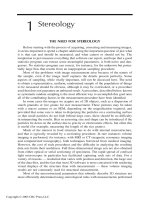The need for transport systems
Bạn đang xem bản rút gọn của tài liệu. Xem và tải ngay bản đầy đủ của tài liệu tại đây (1.08 MB, 54 trang )
The need for transport systems
Why do large organisms have specialised
transport systems while smaller ones do not?
With large size comes a small SA:vol ratio. The
consequence of this is specialised organs of
exchange and with these come a need to
transport materials between the cells and these
sites of exchange which is met with a transport
system.
Achievements of plant transport
Water transport
From roots to leaves
Achievements of plant transport
Water transport
From roots to leaves
Nutrient (sucrose / amino acid) transport
From leaves throughout the plant
Achievements of plant transport
Water transport
From roots to leaves
Nutrient (sucrose / amino acid) transport
From leaves throughout the plant
Ion transport
From roots to growing points
Xylem
• The term ‘xylem’ refers to a tissue made up
from the following cell types: vessels, fibres,
tracheids and xylem parenchyma.
• Xylem vessels transport water (the
‘transpiration stream’) and mineral ions
absorbed by the roots.
• Flow is unidirectional (upward) ‘pulled’ by
evaporation from the leaves
Specialisations of xylem vessels
Lignified
To provide waterproofing and to increase mechanical
strength
Dead
A result of the lignification, this means that cytoplasmic
contents are absent thus reducing resistance to water
flow
Pitted
To allow lateral movement of water from the xylem
Made from fused cells
which have lost their
internal walls
To reduce resistance to water flow and to allow the
cohesive and adhesive forces between water
molecules to aid transpiration
Distributed around the
periphery of the stem
To increase resistance of the stem to bending (lateral)
forces
Held in the middle of the
root
To increase resistance to pulling forces
Held in the midrib of
leaves
To provide support and help present a flat surface for
photosynthesis
Specialisations of xylem vessels
Lignified
To provide waterproofing and to increase mechanical
strength
Dead
A result of the lignification, this means that cytoplasmic
contents are absent thus reducing resistance to water
flow
Pitted
To allow lateral movement of water from the xylem
Made from fused cells
which have lost their
internal walls
To reduce resistance to water flow and to allow the
cohesive and adhesive forces between water
molecules to aid transpiration
Distributed around the
periphery of the stem
To increase resistance of the stem to bending (lateral)
forces
Held in the middle of the
root
To increase resistance to pulling forces
Held in the midrib of
leaves
To provide support and help present a flat surface for
photosynthesis
Specialisations of xylem vessels
Lignified
To provide waterproofing and to increase mechanical
strength
Dead
A result of the lignification, this means that cytoplasmic
contents are absent thus reducing resistance to water
flow
Pitted
To allow lateral movement of water from the xylem
Made from fused cells
which have lost their
internal walls
To reduce resistance to water flow and to allow the
cohesive and adhesive forces between water
molecules to aid transpiration
Distributed around the
periphery of the stem
To increase resistance of the stem to bending (lateral)
forces
Held in the middle of the
root
To increase resistance to pulling forces
Held in the midrib of
leaves
To provide support and help present a flat surface for
photosynthesis
Specialisations of xylem vessels
Lignified
To provide waterproofing and to increase mechanical
strength
Dead
A result of the lignification, this means that cytoplasmic
contents are absent thus reducing resistance to water
flow
Pitted
To allow lateral movement of water from the xylem
Made from fused cells
which have lost their
internal walls
To reduce resistance to water flow and to allow the
cohesive and adhesive forces between water
molecules to aid transpiration
Distributed around the
periphery of the stem
To increase resistance of the stem to bending (lateral)
forces
Held in the middle of the
root
To increase resistance to pulling forces
Held in the midrib of
leaves
To provide support and help present a flat surface for
photosynthesis
Specialisations of xylem vessels
Lignified
To provide waterproofing and to increase mechanical
strength
Dead
A result of the lignification, this means that cytoplasmic
contents are absent thus reducing resistance to water
flow
Pitted
To allow lateral movement of water from the xylem
Made from fused cells
which have lost their
internal walls
To reduce resistance to water flow and to allow the
cohesive and adhesive forces between water
molecules to aid transpiration
Distributed around the
periphery of the stem
To increase resistance of the stem to bending (lateral)
forces
Held in the middle of the
root
To increase resistance to pulling forces
Held in the midrib of
leaves
To provide support and help present a flat surface for
photosynthesis
Specialisations of xylem vessels
Lignified
To provide waterproofing and to increase mechanical
strength
Dead
A result of the lignification, this means that cytoplasmic
contents are absent thus reducing resistance to water
flow
Pitted
To allow lateral movement of water from the xylem
Made from fused cells
which have lost their
internal walls
To reduce resistance to water flow and to allow the
cohesive and adhesive forces between water
molecules to aid transpiration
Distributed around the
periphery of the stem
To increase resistance of the stem to bending (lateral)
forces
Held in the middle of the
root
To increase resistance to pulling forces
Held in the midrib of
leaves
To provide support and help present a flat surface for
photosynthesis
Specialisations of xylem vessels
Lignified
To provide waterproofing and to increase mechanical
strength
Dead
A result of the lignification, this means that cytoplasmic
contents are absent thus reducing resistance to water
flow
Pitted
To allow lateral movement of water from the xylem
Made from fused cells
which have lost their
internal walls
To reduce resistance to water flow and to allow the
cohesive and adhesive forces between water
molecules to aid transpiration
Distributed around the
periphery of the stem
To increase resistance of the stem to bending (lateral)
forces
Held in the middle of the
root
To increase resistance to pulling forces
Held in the midrib of
leaves
To provide support and help present a flat surface for
photosynthesis
Cell A
Cell B
Cell C
ψs=-2.0
ψs=-2.0
ψs=-2.0
Evaporation of
water
Exchanging water between
adjacent cells
• Evaporation of water from Cell C results in
the movement of water from B to C and then
from A to B. How is this water moved along?
A closer look at the cell
boundaries…
Cellulose cell wall
Cell membrane
Cytoplasm
Vacuole
Plasmodesmata
Vacuole membrane
(tonoplast)
Middle lamella
(rich in pectates)
Plasmodesmata
• Small holes in the cell walls between adjacent
cells
• Membrane flows through from cell to cell
• Cytoplasm is continuous between the cells
• Some have threads of smooth ER passing
through increasing communication further
Three modes of water transfer
between cells…
Apoplast route
Three modes of water transfer
between cells…
Apoplast route
Water flows within the cell walls.
Cellulose if freely permeable to water.
Relies on the cohesive forces of water (H-bonds).
cell has no control over water movement since the
water never enters the living contents of the cell
(protoplasm).
By far the most significant route (accounts for ~80%
of water flow between cells)
The Apoplast Route
Cellulose cell wall
Cell membrane
Cytoplasm
Vacuole
Plasmodesmata
Vacuole membrane
(tonoplast)
Middle lamella
(rich in pectates)
Three modes of water transfer
between cells…
Apoplast route
Symplast route
Three modes of water transfer
between cells…
Apoplast route
Symplast route
Water moves between cells via
plasmodesmata.
Water stays in cytoplasm and moves by
diffusion
The Symplast Route
Cellulose cell wall
Cell membrane
Cytoplasm
Vacuole
Plasmodesmata
Vacuole membrane
(tonoplast)
Middle lamella
(rich in pectates)
Three modes of water transfer
between cells…
Apoplast route
Symplast route
Vacuolar route
Three modes of water transfer
between cells…
Apoplast route
Symplast route
Vacuolar route
Water moves by osmosis
Movement is between adjacent vacuoles
The Vacuolar Route
Cellulose cell wall
Cell membrane
Cytoplasm
Vacuole
Plasmodesmata
Vacuole membrane
(tonoplast)
Middle lamella
(rich in pectates)









